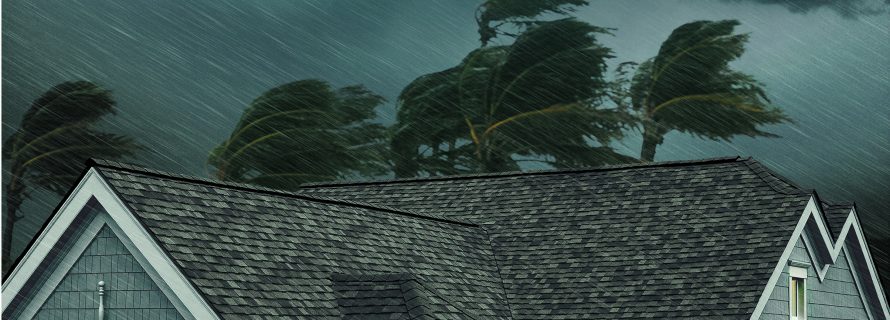What Damage Can Hail Cause to Your Home?

Inclement weather, especially hail, can damage your home. In 2020, there were 4,611 major storms, and State Farm paid over $3.1 billion in hail claims.
Not sure how to prepare for possible hailstorms? Here are some of the main areas of your house that could be impacted. With this info, you’ll know exactly what to look for after a storm and which home repairs might need to be made.
1. Your Windows
Hail can cause cracks and chips to your windows. It can also tear your screens or crack the glazing. Larger-sized sleet traveling at up to 72 mph can create more extensive damage. These pieces can break the glass, leaving your interior vulnerable to the elements.
Be sure to cover any cracks immediately to prevent water damage and injury. Also, consider upgrading to tempered glass, which is more durable.
2. Your Roof
Hail can cause dents or cracks in your roofing. Larger-sized pieces can break tile or tear asphalt. You might also notice missing or fractured shingles. Check for small dark spots where the hail may have knocked off your shingle granules. Also, look for signs of bruising, making the shingles feel softer.
Hail can cause damage to other parts of your roof, like chimneys and vents. If left untreated, these issues can weaken your structure, leading to water leaks. So, it’s best to repair or replace your roof if any hail damage occurs. Consider installing metal roofing for its impact resistance. Also, the higher sloped your awning, the easier it is for hail just to roll off.
3. Your Siding
Wind-driven hail can cause cracks and holes in your siding. Depending on the type of material you have, the impacts will vary. Older vinyl siding may lose some of its flexibility. Wood and metal siding will show dents.
If your exterior is painted, the material can peel, leaving exposed wood. If not taken care of, it can rot due to the elements. You’ll want to fix any siding damage right away to prevent future issues, such as leaks.
4. Your Gutters
Your gutters are another area vulnerable to hail damage. Sleet can dent or loosen the screens or downspouts. Damaged gutters can lead to leaks or foundation issues. If not taken care of, it can lead to costly repairs down the road. Make sure you clean your gutters once a year to prevent clogging.
5. Your Air Conditioning
Larger-sized pieces can cause damage to the system’s fins, restricting airflow. Improper airflow leads to uncomfortable internal temperatures. It can also cause your heating unit to work harder. Hail can even dent the blades or fans, which is more difficult to notice. If not repaired over time, the system could shut down completely.
After a storm, check other parts, like your thermostat wiring, for any signs of damage. Regularly inspect and clean your air conditioner. Also, change the filter every month to keep your system functioning properly.
What to Do If Your Home Is Damaged?
Hail can potentially weaken your home’s structure. Here are some steps you can take if your property is impacted.
1. Check Your Roof and Siding
After a hail storm, it’s essential to examine the extent of the damage. Start with your roof and siding since they are the most vulnerable spots. Consider hiring a professional if you think there’s a need to climb on the roof. You can start by asking neighbors or your Homeowners Association for trusted recommendations.
Then check around your yard for any signs of missing shingles or broken panels. In addition, inspect your home for signs of structural damage, such as cracking. Your garage door is another place to check for exterior damage, as hail can shorten its initial lifespan if not maintained well.
2. Hire a Contractor
Once you spot the damage, you want to get your roof repaired or replaced as soon as possible. Also, a contractor can point out any issues you might have missed, like small cracks. The contractor can then create a detailed list of the problems for your insurance agent.
When hiring a contractor, know your expectations beforehand and interview multiple people. Do background research on them as well. Check their license, references, and online reviews.
3. Talk With Your Insurance Agent
After you understand the problems, contact your insurance company. Carefully review your policy, ensuring it covers wind and hail damage. Keep in mind filing a claim may raise your insurance rates. So, determine your deductible first. Suppose your deductible is close to what the insurance company will pay. It may make more financial sense to cover the costs yourself.
If you choose to file a claim, do it right away. Most companies will only allow you a year to file a hail damage claim. Also, keep the receipts for any work done to submit your claim.
The Impacts of Hail on Your Home
Hail storms can cause costly damage to your home. However, regular inspection of your exterior structure helps minimize the impact. Before the next storm, review this guide to understand the implications of hail.
About The Author: Evelyn Long is the editor-in-chief of Renovated, a magazine for home improvement and décor advice. More of her work can be found on Twitter.
- Additions and New Construction
- All Exteriors
- Alterations
- Basements
- Bathrooms
- Customer Service
- Customer Stories
- Decks
- Design & Planning Show
- DIY
- Doors
- Educational Resources
- Extreme Makeover Home Edition
- Fashion Show
- General Remodeling
- Green Living
- Handyman Home Services
- Home Decor
- Home Entertainment
- Home Improvement
- Home Improvements
- How to Tips
- In The Community
- Kitchens
- Off-the-Wall Remodeling Stories
- Remodeling
- Resources
- Roofing
- Siding
- Social Media
- Sunrooms
- Tips & Tricks
- Trends
- Windows

